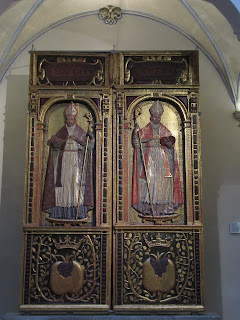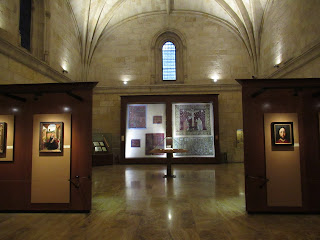After a long half day exploring Granada's amazing Alhambra, we returned to the city center to see more of the city's sights. The central square was Plaza Nueva or New Square with its fountain topped by a stylized pomegranate - the city's symbol representing its always being open and fertile. The plaza was known for its local hippie community, nicknamed for their pies negros or black feet for obvious reasons. However, because of the rain, we didn't see anyone just hanging around.
In the chapel lobby was a painting of Boabdil, the Moorish leader on the black horse, giving the Granada key to the conquering King Ferdinand. Steves wrote that Boabdil wanted to fall to his knees, but the Spanish king had a great respect for his foe and embraced him instead. Behind Ferdinand (in red) was Queen Isabella wearing a crown.
The Palace of Justice dominated one end of the square.
At the other end was the small Plaza Isabel La Catolica with its beautiful statue showing Columbus unrolling a long contract to Queen Isabella which stated the terms of his 1492 voyage. In his travel book on Spain, Rick Steves pointed out that the queen supported Columbus' trip because she was motivated by her desire to spread Catholicism. Spain also needed an alternative trade route to the spices of the Orient once the Ottoman Empire had cut off the traditional overland routes. And Columbus' motive - his desire was money since Isabella told him he could keep one-eighth of all the riches he brought home!
The nearby Madrasa Palace was founded in 1349 by Yusuf I, Granada's Sultan, in the heart of of the old Arab quarter. Once the city came under Christian control in 1492, the building was used as a City Council until 1858. The Muslim prayer room was converted into a chapel in the 16th century. The current facade was added in the 18th century in keeping with that period's style.
Images of Sts. Peter and Paul graced the interior.
Next to the city's Cathedral we'd visited the day before was Granada's top Christian sight, the lavish Royal Chapel in the old town as it held the dreams and bodies of the 'Catholic Monarchs,' King Ferdinand and Queen Isabella. Their marriage united the Aragon and Castile kingdoms which spurred the Christian and Spanish push south to wrest control from the Muslim Moors, a long process known as the Reconquista. This last Moorish capital became the symbol of their victory and, thus, their chosen burial place.
The decision by Isabella to make Granada Spain's capital and the burial place for Spanish monarchs came about for three reasons: 1) with the conquest of the city, Christianity had overcome Islam on the continent; 2) her marriage to Ferdinand, followed by the Granada's conquest, had begun the process of an united Spain; and 3) it was in Granada she agreed to sponsor Columbus.
I read that the original chapel was austere before Ferdinand and Isabella's grandson, Emperor Charles V, added fancy touches. He thought the chapel wasn't dazzling enough to honor his grandparents' importance so he provided the financing for the immense wrought-iron grille and one of the paintings beyond the gate.
The chapel's spectacular High Altar is considered one of the finest Renaissance works in Spain and was dedicated to John the Baptist and John the Evangelist.
Unfortunately, I couldn't take many pictures of the magnificent chapel as they weren't allowed and guards were very attentive! This was the best image I could get of the four royal tombs located in the center of the main altar. The tombs, of the king and queen and those that succeeded them, were carved in Italy in 1521 from Carrara marble. I liked reading that fans of Isabella attributed the bigger dent in her pillow was due to her larger brain!
From the marble toms, we walked a few steps downstairs to see the actual coffins which were remarkably plain. If you read the previous post, you'll remember that Ferdinand and Isabella were originally buried in the Franciscan monastery that later became the upscale Parador hotel in the Alhambra complex.
In the Treasury, we saw Queen Isabella's silver crown ringed with pomegranates, again symbolizing Granada, her scepter and the king's sword.
Our visit to the Royal Chapel concluded with the great art collection of 200 important paintings amassed by Queen Isabella. I wish I could have taken more photos of the exquisite collection, all on wood, that featured works by Botticelli and Flemish masters.
Next post: Spain's best Moorish quarter, the Albayzin, also in Granada.
Posted on February 4th, 2019, from sunny Littleton, Colorado.




















No comments:
Post a Comment